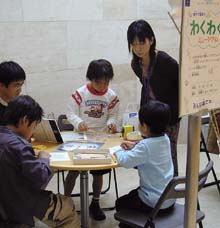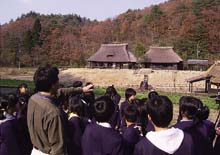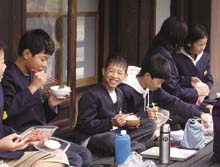
|
The Japanese Ministry of Education, Culture, Sports, Science and Technology has set forth to create spaces at schools and museums for children and post regional instructors to foster the future of Japan. The Ministry has begun supporting various after school and weekend sports activities and cultural events and regional exchange programs. To achieve this goal, the Japanese Association of Museums established a council to promote educational programs for children in local communities at museums throughout Japan. MIHO MUSEUM received a reconsign-ment during this time to start a local children’s educational promotion committee and inaugurated the Waku Waku Museum on October 1, 2004. The Japanese word waku waku comes from the onomatopoeia for bubbling or springing water and refers to a bursting feeling of happiness and excitement. The name Waku Waku Museum thus came about with the idea of inspiring and motivating children to learn about art. The response to our 12-series program far exceeded our expectations, and to meet this demand, the initial number of fifty participants per series was increased. In the end, we received as many as 934 applicants! Much thought went into creating the Waku Waku Museum program, which offered the local community a nurturing environment for children. We asked ourselves, “What kind of program can a museum contribute?” By nature, museums provide spaces for people to encounter art, though at times, it can overwhelm the general public with difficult theories and explanations, which discourage children from becoming interested in art. Rather than imposing difficult ideas on them, our approach is to naturally let sunshine into their hearts. By opening their hearts, children quickly learn to appreciate the beauty of an object. One NPO representative wrote us saying, “We have many little children and are concerned that they may be noisy and get in the way of other museum visitors, so they should just play outside of the building.” However, at Waku Waku Museum, we believe that children, no matter how young, can appreciate art. This NPO group consisted of fourteen members—eight preschoolers, three elementary school children, and three teachers. As planned, their guide cheerfully called out, “Let’s begin!” and started the gallery tour, leading everyone inside, where the children happily sat in front of a sculpture of the Roman god Apollo, much like that which can be seen at the Louvre in France. As the guide began by telling the story of Apollo and Cupid, the children’s cute little eyes began to sparkle and opened up wide as if they forgot how to blink. Two hours quickly passed as the children were guided through the galleries, asking questions and giving their impressions of what they saw. In the bus, on the way back, the children happily talked to each other about their day at the museum. The following day, the representative from the NPO called us, “I recommended your museum children’s program to a parent of a child who attends a class on the verge of collapse. I thought just going there would really help.” Through our program, our staff has had many encounters, and more than anything else, the glowing smiles of so many children have made us happy. In December 2004, when our staff went to assist a Christmas event at the Shigaraki Community Center, an elementary school boy kept looking over and pointing at us, saying happily, “Look, there’s the Miho Museum staff!” We also immediately recognized him as the student, who participated in our Waku Waku Museum sports class. After this class, this boy, participated in another program with his family. This time, he took the adults around explaining where things were exhibited and demonstrated his ability to be an excellent coordinator. Although brief, this enterprise has already started to show potential for the next generation. By offering our budding sprouts sunlight and lots of natural nourishment, they will one day grow into large trees. It is the mission of this program to nurture and foster these budding sprouts. MIHO MUSEUM is often called the mountain museum, where it is most natural to have large trees. And if we have large trees, water begins to spring up, and small birds and animals are revived, and life is brought back to nature. Tsutomu KOMAI, Educator
|




